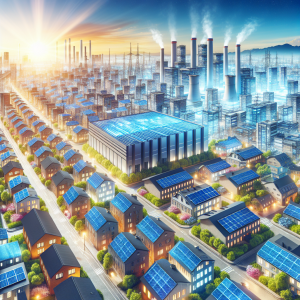Exploring the Future of Sustainable Architecture
Sustainable architecture has shifted from being a niche area to a central topic in building design and construction. As global awareness of environmental issues grows, architects and builders face increasing pressure to create buildings that harmonize with the environment, reduce energy consumption, and promote well-being.
### The Current State of Sustainable Architecture
Sustainable architecture today is a vibrant field with innovations spanning materials, designs, and technologies. One of the most significant developments in this arena is the adoption of green certifications such as LEED, BREEAM, and others. These certifications drive architects to adhere to higher environmental standards, ensuring buildings are energy-efficient, resource-conscious, and created with minimal environmental impact.
### Integrative Design Principles
At the core of sustainable architecture is integrative design, which considers the building’s entire lifecycle, from conception through operation to eventual demolition. This approach strives to limit environmental damage at each stage. Architects now prioritize site analysis, ensuring structures work with the local climate and ecosystem, instead of against it. By harnessing passive solar energy, natural ventilation, and shading, buildings can significantly reduce their energy needs.
### Material Innovation
Perhaps the most exciting frontier in sustainable architecture is the innovation in building materials. There is a growing trend toward using renewable, recyclable, and low-carbon materials. Cross-laminated timber (CLT), for instance, offers a sustainable alternative to concrete and steel, and captures carbon dioxide in the process. Additionally, bio-based materials like hempcrete and mycelium composites not only have low environmental footprints but can also improve indoor air quality by regulating humidity levels.
### Energy Efficiency and Renewable Energy Integration
Modern sustainable buildings are highly energy-efficient, often generating as much energy as they consume through integrated renewable energy systems. Solar panels, wind turbines, and geothermal energy have become staples in sustainable architecture, with buildings frequently incorporating on-site energy generation to minimize reliance on fossil fuels. Innovations, such as building-integrated photovoltaics (BIPVs), seamlessly integrate solar cells into building materials like windows and facades, thus harnessing energy without compromising aesthetics.
### Advances in Water Conservation
Water conservation is another critical component. New technologies prioritize efficient water use, from advanced rainwater harvesting systems to greywater recycling. These systems enable buildings to reduce their reliance on municipal water supplies and contribute to broader water conservation efforts. Innovative plumbing fixtures, such as low-flow faucets and toilets, further drive water efficiency, making a significant impact on reducing urban water demand.
### Smart Building Technology
The advent of smart technology has revolutionized sustainable architecture, enabling more efficient building management. Internet of Things (IoT) devices and sensors allow real-time monitoring and adjustment of lighting, temperature, and energy consumption. Smart systems ensure that resources are used only when necessary and can provide predictive maintenance alerts, minimizing the building’s lifecycle costs and environmental impact. Additionally, AI-driven systems can analyze vast amounts of data to optimize building performance continuously.
### Urban Planning and Green Spaces
Beyond individual buildings, sustainable architecture increasingly influences urban planning. Cities are integrating green spaces and urban forests to improve air quality, reduce heat island effects, and boost residents’ quality of life. These green spaces are essential for biodiversity and provide spaces for community gatherings, promoting social sustainability.
### Resilience and Adaptability
As climate change presents unpredictable challenges, sustainable architecture must embrace resilience and adaptability. Design solutions are emerging that can withstand extreme weather conditions and are flexible enough to adapt to various future scenarios. This includes designing buildings in flood-prone areas with elevated structures or floating foundations and using materials that can endure higher temperatures and humidity levels.
### Education and Advocacy
For sustainable architecture to thrive, education and advocacy are crucial. Educational institutions are embedding sustainability into their curricula, ensuring the next generation of architects is equipped with the necessary knowledge and skills. Professional organizations and advocacy groups are also crucial in promoting sustainable practices, providing guidelines, networking opportunities, and resources for innovation-sharing.
### Regulatory Frameworks
Government regulations play a pivotal role in advancing sustainable architecture. Incentives such as tax benefits, grants, and subsidies for eco-friendly construction practices encourage developers to adopt sustainable methods. Stricter building codes and zoning laws focusing on sustainability standards are essential for setting baselines that protect the environment and encourage innovation in the field.
### Community Engagement
Incorporating community input in sustainable building projects ensures that the needs and values of local populations are respected and integrated into architectural designs. Participatory design processes not only lead to more socially equitable solutions but also foster community buy-in and stewardship over completed projects.
As these diverse elements of sustainable architecture continue to evolve, they promise to redefine the future of building design and urban living. This burgeoning field not only addresses the pressing environmental challenges of our time but is also crucial in crafting livable, equitable, and resilient communities worldwide. Through continuous innovation, collaboration, and commitment to sustainable principles, architecture will significantly contribute to the global efforts toward a more sustainable future.




